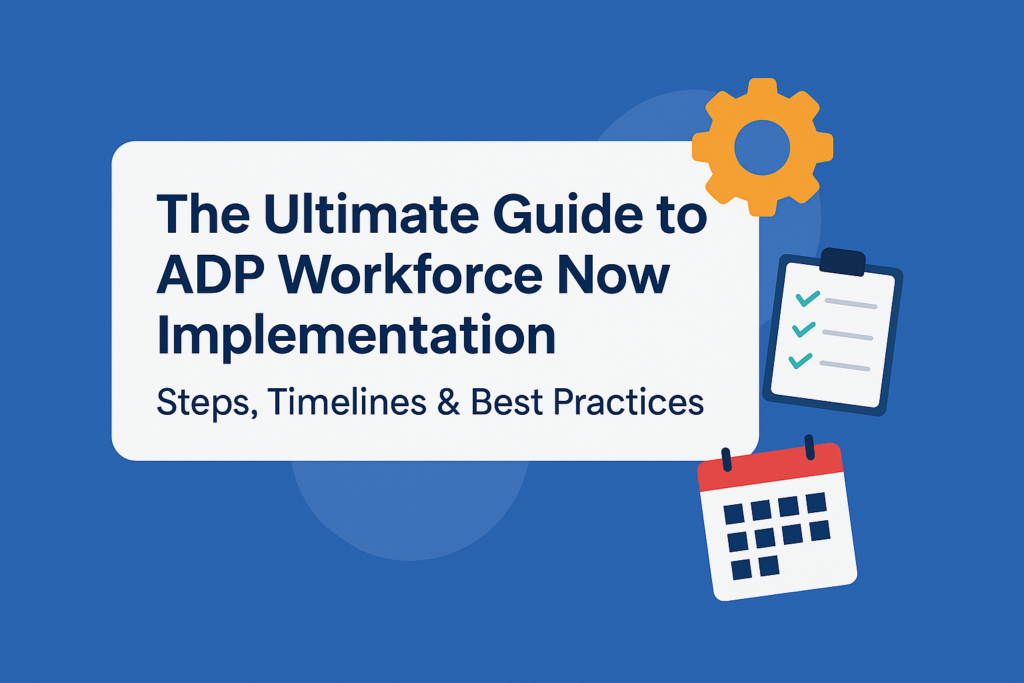When businesses evaluate Human Capital Management (HCM) solutions like ADP, the conversation often starts with software licensing fees. But the Total Cost of Ownership (TCO) goes much deeper than that. Understanding the real cost of ADP implementation means looking beyond price tags into integration complexity, internal resource commitments, support needs, and ongoing maintenance.
This comprehensive guide unpacks the components that make up TCO and helps HR and IT leaders make informed financial decisions for their ADP journey.
What is Total Cost of Ownership (TCO)?
The Total Cost of Ownership is the cumulative cost of acquiring, implementing, using, and maintaining a solution over time. For ADP, TCO includes everything from license fees to internal resource allocation and post-implementation support.
Key TCO Elements:
- Software Licensing & Subscriptions
- Implementation & Configuration Costs
- Data Migration & System Integration
- Training & Change Management
- Ongoing Support & Maintenance
- Internal Resource Allocation
1. Software Licensing & Subscription Costs
ADP typically operates on a subscription-based pricing model. The base license cost can vary depending on:
- Number of employees
- Modules selected (Payroll, HR, Time Tracking, etc.)
- Geographic coverage (single country vs. global)
Tip: Always confirm what’s included in the license fee — some features are add-ons.
2. Implementation & Configuration Costs
This is where companies often underestimate. Successful ADP implementation requires:
- Consultation & Discovery
- System Configuration & Workflows
- Testing & Validation
Hiring an expert partner like ADP Experts reduces risk and accelerates value realization.
3. Data Migration & System Integration
Cleanly migrating data from legacy systems is critical. This phase includes:
- Data auditing & cleansing
- Field mapping & transformation
- Validation & rollback testing
Complexity increases when integrating ADP with ERPs (like SAP, Oracle) or third-party HR tools.
4. Training & Change Management
Adoption determines ROI. Training your team on how to effectively use ADP is essential. Costs here include:
- Training sessions (onsite/remote)
- Creation of user manuals & SOPs
- Change management workshops
5. Post-Implementation Support & Optimization
Even after going live, you need ongoing support to manage:
- System updates
- New feature rollouts
- Compliance adjustments
Retaining a managed service provider can stabilize performance and reduce long-term overheads.
6. Internal Resource Commitment
Never ignore internal resource costs. Your HR, IT, and Finance teams will contribute significant time to:
- Process mapping
- Data validation
- User acceptance testing
TCO Comparison Table
| Cost Component | Estimated Range (Mid-size Org) | Frequency |
|---|---|---|
| License & Subscription | $25,000 – $100,000/year | Annually |
| Implementation Services | $40,000 – $200,000 | One-time |
| Data Migration & Integration | $15,000 – $75,000 | One-time |
| Training & Change Management | $5,000 – $25,000 | One-time |
| Support & Optimization | $10,000 – $50,000/year | Annually |
Hidden Costs to Watch For
- Custom integrations and connectors
- Unforeseen compliance requirements
- Delayed implementation timelines
- Shadow IT costs and duplicated efforts
Reducing Your ADP TCO: Pro Tips
- Scope It Right: Define exact requirements before signing contracts.
- Use Experts: Work with experienced ADP consultants to avoid rework.
- Train Early: Equip your users before go-live.
- Automate Wisely: Use native APIs for seamless data flows.
Work with ADP Experts to Maximize ROI
At ADP Experts, we help clients understand the full financial landscape of ADP implementation. Our consultants ensure a smooth transition with minimal cost overruns.
Book a free consultation to get a tailored TCO estimate for your business.
Conclusion
The cost of implementing ADP goes far beyond license fees. Taking a strategic view of TCO allows HR and IT leaders to budget realistically, avoid hidden costs, and realize long-term value. Understanding and planning for the Total Cost of Ownership can be the difference between a painful implementation and a transformative success.





